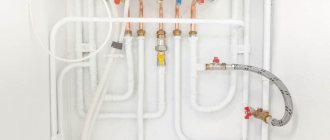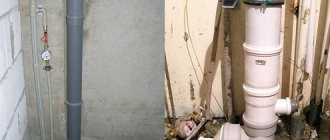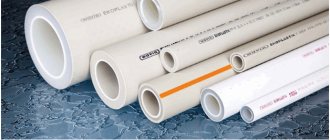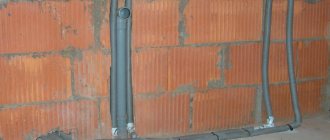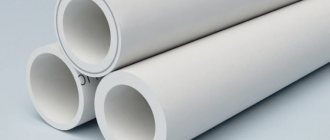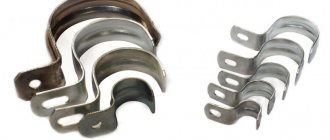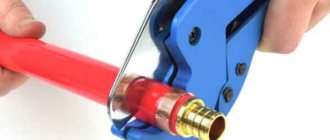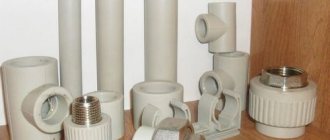It is generally believed that plumbing work, such as the installation of heating systems, water supply and sewer systems, requires the involvement of highly qualified specialists. However, practice shows that when doing work with your own hands, you can often achieve better quality of work than hired workers. The fastening of clamps can be rigid or free (floating). When installing heating, water supply and sewerage systems, the correct and reliable fastening of all elements of the system. Failure to comply with the requirements can lead to deformation and rupture of joints and, as a result, to the appearance of leaks.
Therefore, we will consider the technology for properly fastening pipes to the wall. The required set of elements for fastening sewer and heating pipes to the wall: pipes, fittings, transitions, couplings, etc.; clamps for fastening plastic pipes; supports; brackets; fasteners (screws, dowels, anchor bolts, etc.). Fastening of clamps can be rigid or free (floating).
Loose fastening prevents deformation during thermal expansion and compression. If installation is carried out in a heated room, rigid fastening of the clamps is allowed. When installing sewer pipes, special attention must be paid to the presence of a slope towards the drain point. The slope should be 2 cm per linear meter. The use of supports for pipes, as well as the use of wooden plugs instead of standard dowels, is not allowed . For hanging heavy elements, as well as when attaching to the ceiling, it is advisable to use anchor bolts. Sequence of operations Diagram of the fastening element. Marking of the pipeline axes.
A line is drawn on the walls along which the system will be mounted. Supports must be placed at all connections and at bends. The distances between supports in linear sections of the pipeline should not exceed 10 pipe diameters. If it is necessary to make an indentation from the wall, special brackets are used.
However, it must be borne in mind that the distance to the wall should be minimal. This is important both for the rigidity of the fasteners and for saving space in the room. When the fastenings are ready, you can install the pipes. Depending on the design of the clamps, the pipes are either snapped into the support or screwed with studs.
It is desirable that the clamps be equipped with rubber seals; this reduces vibration and compensates for thermal expansion. Sometimes pipelines are laid in special recesses in the wall - grooves or channels. This contributes to their more reliable fastening and insulation. Laying plastic pipelines in the thickness of walls and ceilings When laying pipes in the thickness of concrete, it is worth thinking in advance about removing obstacles to their thermal expansion. A channel is cut into a brick wall in such a way as to prevent overvoltages. If the channel will be sealed with plaster, the pipes should be wrapped in any soft material.
If high temperatures are possible, the pipeline in these places must be laid with insulating material. If the pipeline passes through the ceiling, it is necessary to ensure tightness and sound insulation. When laying pipes in the thickness of concrete, it is important to remove obstacles to their thermal expansion. Also, the pipeline must be well fixed to prevent it from moving when laying concrete. Features of fastening sewer and heating pipes When installing sewer pipes, a number of conditions must be met. First of all, they must run with the required slope along their entire length and not interfere with the laying of other pipelines. Further, plastic products are very sensitive to temperature changes.
Therefore, it is important to select the correct diameters of the clamps to ensure freedom of movement in the fastening points. It is better to use pipes and fasteners of the same brand, which will make the pairing ideal. Layout of fastenings Fastenings should be installed exclusively on smooth parts of the pipe. The distance from bends should be at least 15 cm. The size of sewer pipes affects the method of their fastening. With a pipeline diameter of 50 mm, fastenings are made at a distance of 40 cm, but if the diameter is 100 mm, the distances are doubled.
If plastic pipes are connected using a special coupling, the coupling itself is attached. A special case is when the pipeline is filled with a cement screed. Then, to minimize wear, the pipe should be insulated from the cement with paper, cardboard or corrugated sleeve. Above the level of the screed, a special outlet is left, the so-called revision.
There are some other features of fastening sewer pipes. When installing risers, you must ensure that the distance to the wall is at least 5 mm. A clamp with rigid fixation must be placed next to the socket to prevent the pipe from moving after some time.
And the second fastening must be loosened in order to avoid internal deformations. Now regarding the fastening of heating system pipelines. Heating distribution in rooms should begin with the installation of radiators. It is advisable to mark the attachment points taking into account a slight deviation from the horizontal towards the highway. This will be almost invisible to the eye, but will help remove the air plug from the radiator.
But this method is not suitable for heating systems with counter-movement of air and coolant. Here the air plug will be pulled back into the radiator. In this case, the radiator is placed horizontally and an air vent is used. The radiator is usually hung in a package to avoid contamination and damage. Share a useful article: Similar articles:
Polypropylene pipes are elements of a hot and cold water supply system.
Fastening for polypropylene pipes is made in various ways. There are two main types of installation: external and inside walls. Regardless of the method of installing pipes, before starting work you need to stock up on related consumables.
Fastening material - different shapes
Clips - their meaning and installation details
The clip is made from a special material - nylon.
It has such useful properties as high heat resistance and resistance to mechanical stress. Among the technical characteristics of the clip, you need to pay attention to the diameter; it must correspond to the size of the outer diameter of the polypropylene pipe. Installation of clips has its own rules, the implementation of which determines the service life of the finished communications system.
Single clips and double clip
The main issue that is important not to miss is the step size between the clips. If you install the clips too far apart, there is a risk of sagging at the support points.
When installing a communication system with two parallel pipes, use a double clip.
Correct pitch between clips
In what cases are clamps used?
It is recommended to fasten polypropylene pipes to the wall using clamps in cases where it is necessary to install large-diameter pipes with a fairly heavy weight. The clamps are a design with a screw tie and a rubber internal gasket, which is necessary to compensate for vibration. Thanks to this, they reliably hold the pipe even when strong vibrations occur.
The clamps are equipped with a dowel and a pin.
The mount can be made of metal or plastic. When laying polypropylene pipes, it is better to choose clamps from similar raw materials: this way you will ensure the same strength indicators for the entire structure. Installation of fastening material can be rigid or floating:
Rigid fastening is made by tightening the clamp extremely tightly around the pipes. A rigid coupling is required in areas below the bell.
Thanks to the rigid fixation, the possibility of displacement of the communication system is eliminated. A floating fastening indicates the presence of a gap between the pipes and the clamp. The fastening is tightened in such a way as to allow free movement of the pipe. The mobility of the fasteners allows the pipes to expand during temperature changes.
How to attach the clamp
Fixation methods and advantages of fastenings
Fastening elements for polypropylene pipes of small diameter are made of the same material and have the appropriate physical characteristics. If it is necessary to fix a pipeline of a larger cross-section to the wall, metal products are used.
There are only two main types of fastenings - clamps and clips, which ensure reliable fixation of the structure if the installation rules are followed.
Installation using clips
Polypropylene clips are the best option for installing a heating or plumbing system from small diameter pipes. These fasteners are heat-resistant and durable, and the process of fixing the pipeline does not take much time.
The advantages of this type of fastening include:
- No need to purchase special tools. It is enough to have a hammer drill, a screwdriver or screwdriver, a hammer and measuring tools (level, tape measure).
- The strength of the system is guaranteed, without sagging pipe sections and leaks. However, this point is implemented only if the step sizes between the individual fasteners are observed.
- The finished structure looks aesthetically pleasing: after final assembly there is no need to hide it.
- It is possible to install parallel, adjacent pipes using a special double clip.
- The pipeline is not only quickly assembled, but also dismantled instantly. No tools are needed for this - just remove the pipe from the mount.
Note! To increase the reliability of fixation, you can use clips with special straps. They will provide additional strength to the entire structure.
Mounting clamps
A clamp is a plastic or metal structure made of half rings with a screw tie, attached to the surface using dowels. This type of fastener is intended for large diameter pipes, as it can withstand significant weight. When installing a pipeline, there are two options for fixing it with clamps:
- Floating, when when the half rings are tightened, a small gap remains between them and the pipe. The loose fastening allows for movement, which is important for heating structures and hot water supply. Deformations occur when a material expands or contracts due to temperature changes. In this case, the diameter of the clamp is selected slightly larger than the external cross-section of the pipe.
- Rigid - carried out by tightening the half rings as tightly as possible when tightening the bolts. Such fastening is necessary to prevent mobility in the area of the pipeline sockets (fixation points are located below).
We recommend that you read: Using uPVC pipes in pressure systems
Note! For very large diameter pipes, it is necessary to use clamps made of metal. These structures must be equipped with rubber gaskets to prevent noise in the event of vibration.
Pipe fastening technology - step-by-step instructions
Before installation work begins, the pipes are connected using butt welding, polyfusion welding or the electrofitting method. If you carefully familiarize yourself with the pipe laying technology, the process will not take you much time:
- The first step is to mark the path of the future pipeline along the perimeter. Please note that it should be installed with a slight slope - this way you will eliminate the possibility of water freezing in the pipeline even in an unheated room (for example, in a country house). Using a drill, you need to make holes for the dowel-nails. Pre-prepared mounting clips for polypropylene are inserted into the holes pipes. We insert the dowel into the hole using a hammer and screwdriver. The final stage of the work is installing the pipes into the clips.
Appearance of the finished fastener
Is it possible to install PP pipes in the wall?
Polypropylene is a material that has high resistance to chemicals and corrosion.
Therefore, installing pipes in the wall is quite acceptable. In order for the communication system to last for a long time, it is important when laying to leave the necessary space gap for the expansion of the hot water pipe. In addition, the system itself should be as monolithic as possible, with the least number of connections.
The pipe along its entire perimeter must be additionally protected with thermal insulation. This can be corrugated cardboard, glass wool, mineral wool or other insulation. This way you will protect the structure from fogging.
Laying PP pipes in the wall
Types of holders for corrugated pipes
Fasteners for corrugated pipes are not fundamentally different from fastenings for smooth pipes. This is a product molded from plastic, which is attached to the surface on one side and fixes the pipe on the other. The choice of the most suitable type of fastener depends on the surface to which the pipe will be attached and the preferences of the installers.
The holder for the corrugated pipe must have sufficient strength and not lose its properties under the influence of temperatures. That is why fasteners are made from durable ABS plastic, polypropylene or polyamide. For special site safety requirements, halogen-free fasteners are produced.
Clips are the most common type of fastening. They provide not only reliable fastening of the pipes to the surface, but also the ability to easily remove them if necessary. It is better to use clips for vertical surfaces, since when attached, say, to the ceiling, the corrugation may fall out due to temperature changes or under prolonged exposure to gravity. For some types of surface (concrete, wood) it is better to use such a corrugation holder with an attached dowel.
For ceilings, a corrugated holder with a latch, a clamp or a sliding holder is better suited. They are distinguished by the fact that they completely cover the entire diameter of the pipe, providing excellent fixation. When using a clamp fastening, the main thing is not to overtighten the pipe, otherwise it may be damaged. The clamp holder for corrugated pipes is also the most economical, because it has the lowest price.
In some cases, it is justified to use a holder for corrugated pipes type F. It is a plastic dowel with one or two “horns” that secure the pipe. Its main advantage is its competitive price. This is a compromise between sliding and clamp holders.
Choosing the most suitable type of corrugation holders is half the battle. The second half is to install them correctly. So, depending on the diameter of the pipe, the fastening step will be from 30 to 50 cm. This frequency is necessary to avoid sagging of the pipe with the cable, which is unacceptable by safety requirements. You must remember to arrange the fastening at a distance of 10-15 cm from the mounting box or the end of the pipe.
We install pipes in the wall
Any installation work begins with marking. You can do it with a simple pencil. Next, proceed to the main work:
- Using a grinder (perforator), you need to make 2 parallel grooves in the wall strictly according to the markings - grooves. To work with an angle grinder, you should use a disk with diamond-cut teeth or a simple disk for cutting stone. Using a chisel or hammer drill, remove the material between 2 markings, connecting them into one. A polypropylene structure is inserted into the finished grooves. The polypropylene pipes in the groove are covered with cement mortar on top. The finishing is done with plaster or other building material.
The final action, an hour after installation, is to test the system. The pipes must be filled with water and checked for leaks, sagging and other malfunctions in the operation of the water supply system. If none are found, congratulations, you have correctly attached the PP pipes.
Leaky sewer pipes can instantly turn a house or apartment into a garbage dump with all the accompanying stench and dirt.
It’s unlikely that anyone enjoys leaks and disgusting odors. The pipelines need to be replaced immediately. But how can sewer pipes be secured so that they last as long as possible?
How to fasten polypropylene pipes
To install highways using polypropylene pipes you will need:
1. Fastening materials:
- plastic clips (or clamps) of the required size;
- dowels
2. Tools:
- hammer;
- drill;
- shaped screwdriver;
- knife/scissors for cutting polypropylene pipes;
- yardstick;
- level;
- pencil or marker.
Fastening of polypropylene pipes must be carried out taking into account the risk of mechanical deformation and thermal expansion of the line. Experts recommend laying pipes in grooves, suspended ceiling structures, in walls, in screeds, along walls under baseboards, or in an open way.
- Installation of propylene pipes must be carried out at an ambient temperature of at least + 5 °C.
- Pipes with an outer diameter ranging from 16 to 32 mm should be bent with a radius that is at least 8 outer diameters. Such operations are performed at air temperatures above 15°C.
- Propylene pipes must be protected from open flames.
- If during the wiring process it becomes necessary to cross pipelines, then it is necessary to use special fastening parts for crossing.
- When connecting pipes using threads, special fittings of the required size are used. Threading on a polypropylene pipe is prohibited.
- If there are sections of metal pipes in a polypropylene pipeline, then the connection must be made without soldering or welding, as this can lead to overheating of the polypropylene fasteners.
Pipelines are laid with a slope of at least 0.5%. A drain cock or drain valve must be installed at the lowest point of the pipeline. Long pipelines should be divided into separate elements, which can be closed using ball valves or straight-through shut-off valves. This is necessary to simplify maintenance and repair work on the polypropylene pipeline. At points where it is planned to install faucets and other plumbing equipment, a universal wall mount with axial adjustment from 10 to 15 cm is installed.
Distance between fasteners
Maximum spacing for fastening polypropylene pipes PN 10
for horizontal highways:
Distance between fastenings of polypropylene pipes PN 16
when laying horizontally, it should not exceed the values indicated in the table:
Mounting distance for polypropylene pipes PN 20
(maximum spacing between supports) for horizontal installation should not exceed the following values:
For vertical mounting, the values presented in the table must be multiplied by 1.3.
For polypropylene pipes STABI PN 20
with reinforcement:
Methods of fastening polypropylene pipes:
| On the folds | At points where it is necessary to make a branch line |
| At reinforcement attachment points | Using clamps |
| Between connections | Fastening next to the fitting |
When fastening polypropylene pipes, you should take into account operating conditions (temperature\pressure), permissible linear expansion, as well as connection options. There are two main mounting options:
- motionless (there is no possibility of moving the fastening along the axis of the polypropylene pipe);
- movable (compression/extension of the line is provided without changing the position of the axis).
Read material on the topic: Advantages of polypropylene pipes
Fastening material: plastic vs metal ↑
The vertical riser and horizontal pipelines of the intra-house sewerage system can be laid inside the walls in a closed installation or fixed to the walls and ceiling. The first option involves gating, which is accompanied by dust and is not applicable in all homes. Using special fasteners is more practical.
Various mounting options
For open installation, pipelines must be secured.
Otherwise, they may sag under their own weight and become depressurized. The quality of fasteners directly affects the durability of the sewerage system. Sewage pipe manufacturers produce a wide variety of fasteners for installation. All of them are divided according to the material of manufacture into two groups:
- Metal. Plastic.
Fastenings for sewer pipes made of metal are stronger than their plastic counterparts.
But this strength is in many cases excessive. Plastic products are now quite reliable. Plus, plastic fasteners are more aesthetically pleasing and presentable.
In addition, they will not rust in conditions of high humidity in the bathroom. The two main options for pipes for internal sewerage systems are cast iron and plastic. Often, galvanized fasteners are selected for cast iron, and polymer fasteners for plastic.
In many ways, the choice between metal and plastic depends on the preferences of the home owner. Both options allow you to securely fasten sewer pipes at the desired slope both on the walls and on the ceiling. However, metal fasteners do not look as elegant as plastic ones, so they are most often used for installation work in utility rooms and basements.
Basic methods of installing sewer systems
Before laying the entire sewer system in the house, they strengthen the pipes. In order to avoid unpleasant consequences in the future, such installation is carried out skillfully, using various fastening methods:
Types of pipeline fastenings
- to avoid deformation of the pipes during wiring, a compensation method is used;
- fasteners for sewer pipes taking into account sliding friction are used to prevent pipes from deviating from the center line;
- You can strengthen the structure with extra turns using fittings; they are also used to connect pipes with sanitary equipment;
- The optimal and most popular option is fastening with clamps.
The latter method creates a good fixation of sewerage elements. The fastener has a convenient design that allows it to be easily and securely mounted on the wall - it is a dowel, anchor or screw device.
Typically, pipes are included in the pipeline kit, but if the need arises to purchase clamps, you can choose both plastic and metal. But at the same time, you should take into account the design of the room in which the system runs.
Advantages of pipe clamps
Plastic clamps are more suitable for open installation - they are more attractive. With a hidden pipeline, this point is not important, so you can choose metal.
Types of fasteners for sewer pipes ↑
When choosing the method and type of fastening, it is necessary to take into account the material of manufacture and the diameter of the sewerage pipelines, as well as the length of the secured segment. The weight that the fasteners must withstand depends on these parameters.
Types of fasteners for fixing drains
Sewer pipes can be secured using:
- hangers-hooks; brackets; clips; clamps.
The first option is intended for attaching pipelines exclusively to the ceiling, the second - only to the wall, and the third and fourth can be used in both cases. The choice of holders is quite varied, but the most popular and reliable are all kinds of clamps.
Technology of work execution
Scheme of installation of sewer pipes
In plumbing work, two types of clamp attachment of lines are used: rigid and floating. In the first case, the pipes are fixed with crimping parts, which are placed under the socket or placed on the body of the fitting element. Their main task is to reliably fix the connection point between sections of pipeline or pipes and fittings.
The second option is carried out using guides or support fasteners, which ensure the integrity of the pipeline during thermal deformations. It is needed if communications are made of polymers, since they change under the influence of temperature changes. The internal diameter of the fixing part must be greater than the external cross-section of the pipe section, which allows the pipeline to move in the longitudinal direction.
The same types of fastenings are used for both options. But there are also fasteners that are used exclusively for floating fixation. This type of clamp is not equipped with clamping or tightening bolts. They are convenient because they snap into place and do not require the use of special equipment during installation.
Installation of standard clamps is simple. A hole is drilled in the wall, a clamp is attached to the dowel, after which the pipe is installed in the clamp and the crimping screws are tightened. When using plastic elements, they simply snap into place.
If it is necessary to leave a large distance between the sewerage pipeline and the basement floor, the installation of fasteners is performed differently. Anchor dowels with internal threads are fixed in the ceiling, a threaded rod of the required length is screwed in, and a clamp is installed on it.
Types of clamps ↑
A standard clamp fastener consists of an installation unit and a clamp bracket in which the waste pipe is fixed. It is attached to supporting structures using dowels, self-tapping screws, studs and anchors. The clamping bracket is tightened with latches or screw ties.
Clamp diagram for fastening pipes
Depending on their purpose, pipe clamps are divided into:
- Support. Crimping. Guides.
The first ones are designed for attaching vertical risers and hanging sewer pipes from the ceiling. The latter are used when compressing the joints of drains and their connections with fittings.
And still others help fix the pipes at the required angle and keep them in this state. Most clamp products have a rubber insert that securely grips the pipe on one side and allows it to move slightly on the other. But there are options without rubber gaskets. The choice here depends on the method and technology of installing the sewer network.
Varieties
In construction and plumbing stores you can find different clamps for securing pipes on vertical and horizontal surfaces. For convenience, a classification system based on design features was created. Types of fasteners:
- Worm-shaped. Products for fastening small diameter pipes. They work on the principle of a tape clamp with imitation thread.
- Tape fastening, which is complemented by a plastic latch. It is a plastic tape with a clamp at one end. Suitable for securing tubes of different diameters.
- U-shaped clamps made of heat-resistant plastic. They have a special hole for dowels or bolts. Suitable for installation of hot and cold water supply pipelines.
Pipe clamps that provide rigid fixation are only suitable for socket connections.
Clamps are also divided into reusable and disposable. The first option is suitable for installing pipelines on various surfaces. To remove the tubes, the clamp can be unscrewed with a screwdriver. The second version of clamps is disposable, which is suitable for temporarily securing wires and pipes before using reusable clamps.
Plastic Pipe Clamps
Rigid and floating mounting schemes ↑
Sewer pipes can be fastened with the same clamp firmly, tightening the clamps all the way so that the drains cannot be moved from their place. Alternatively, the bolts can be left slightly loose so that the riser can “float” in the fastener.
Clamps are needed to fix both horizontal and vertical pipes
When heated and cooled, plastic tubular products slightly change their geometry. To ensure their integrity, a floating fastening method is used. In this case, during linear expansion, the pipelines will not be damaged or depressurized.
Advice! The rigid version of fixing waste pipes is recommended to be used only in heated rooms with minimal changes in air temperature.
If the sewerage system is laid in a room without heating, then the pipes should be attached to the walls and ceiling using floating technology. The temperature inside will vary widely, heating and cooling the pipes. And they should not be damaged.
Rules for attaching cables to the ceiling
Attaching wiring to the ceiling is more difficult than to the wall.
- Doing such work alone is inconvenient and often unsafe, so an assistant is needed.
- The wiring can be laid openly, in corrugated hoses, in grooves, followed by plastering.
- When attached to the ceiling, the distance between the clips should not exceed 40 cm. The exception is installation on special installation galleries or in rigid pipes.
Fixing devices are placed in places of rotation and abutments to connection points, regardless of the distance to the previous place of fixation.
Like any work involving electric current, the installation of fasteners has many features, failure to comply with which entails unpleasant and even tragic consequences. Such operations must be performed by a specialist with electrical installation skills.
Did you manage to solve your problem using the recommendations from the article?
Yes!
45.28%
No. More answers required. I'll ask in the comments now.
37.98%
Partially. There are still questions. I'll write in the comments now.
16.74%
Voted: 466
Installation of sewer pipes to the ceiling and walls ↑
The sewer network consists of a variety of elements that are subject to vibration, temperature influences and mechanical loads during operation. There is a whole set of rules, compliance with which during installation ensures reliable operation of the entire system.
Wall and ceiling mounting diagram
When installing sewer pipes you should:
- Make markings on the walls indicating the fastening points and the slope axis. Fix the fasteners on the walls and ceiling. Place the pipelines in the holders.
Fastening sewer pipes using clamps requires a minimum clearance between the drain and the wall. If you need to leave a larger gap there, it is better to choose brackets or hooks.
Important! Only with the help of fasteners can you accurately set the slope of the collector to the two to three degrees recommended by building codes and protect the sewer from blockages.
The distance between the fasteners depends on the diameter of the drain and the material from which it is made. Plastic pipelines are quite lightweight; for them, fasteners in horizontal sections can be spaced 1.5–2 meters apart. And to fasten cast iron sewer pipes, holders will have to be installed every half a meter.
Fasteners are installed on bends and branches of pipelines
However, in practice, fastening is carried out in places of branches, connections and bends, where communications are subject to the heaviest loads. You should not attach sewer pipes where it is most convenient for the technician. The placement of the holders should maximize the reliability of the entire system.
Design and purpose
Plastic pipe clamps are narrow strips with a special lock attached to one end. There are many notches on the surface of the strip, which are intended for crimping selected parts and pipeline elements.
Purpose:
- fixing pipes and hoses to vertical and horizontal surfaces;
- tying cables and wires;
- connection of individual pipeline elements.
Plastic clamps are suitable for installation work indoors and outdoors. Fastening elements are made of ABS plastic, resistant to shock and mechanical stress.
Laying communications in channels ↑
To make it possible to cover the sewer with decor, grooves are punched into the walls. Inside them, the pipelines are secured using the technology described above using clamps. It should be taken into account that there should be no interference with the linear expansion of the collectors.
In the grooves, the drain should also be secured with clamps
Grooving is quite a troublesome task, but with this installation method, the fastening of communications is more reliable. In this case, the pipes are held not only by fasteners, but also by the edges of the groove in the wall.
Floating or rigid mount
It is necessary to understand that pipe fasteners installed using a clamp can be rigid, with a strong grip around the pipe, or floating. Floating fastening is performed to maintain the integrity of the pipes during thermal deformation. Both types of fastening can be applied to the same clamp connection. However, there are also clamps that are designed exclusively for floating mounting. They are usually not equipped with tightening and clamping bolts. They simply snap into place; their installation does not require the use of professional equipment.
One of the important components of the design of a plumbing pipe clamp is a special gasket, which is located between the sewer pipe and the female part of the fastener. The main task of the laying is to neutralize noise arising from internal loads on the pipes and vibration. Having examined the popular types of clamp connections and the features of their design, let us turn to the basic rules for their installation.
Video: device of a universal clamp for fixing pipes ↑
To secure cast iron and plastic sewer pipes, it is enough to use special clamps with rubber gaskets. Their installation is extremely simple and does not require special tools. You just need to correctly prepare a plan for laying out sewer pipelines and mark on it all the installation locations of fasteners.
Content:
Sometimes, when performing repair work, it is necessary to attach polypropylene pipes or other means of communication to the wall, for example, to set up a pipeline. The task, at first glance, looks quite simple, but it is not. How and with what to attach the pipe to the wall will be discussed in this article.
How to make a clamp with your own hands
In certain cases, it becomes necessary to quickly make a fastening element with your own hands.
You will need a galvanized or stainless steel sheet 1 mm thick. A strip of the required width (usually 2.5-4 cm) and a length greater than the diameter of the pipe by 4 cm is cut out of it.
One or two holes are drilled at the edges of the plate a centimeter from the end. The plate is bent, forming “ears” with holes. Find a bolt and nut, and the kit is ready. To complete the picture, add a rubber gasket inside.
Tools and materials required for pipe fastening
To attach pipes to the wall, various tools and accessories are required. Their choice depends on the materials from which the communication system is made. In this case, it is necessary to take into account the length, diameter and weight of the line.
Used fasteners for pipes in the wall:
Clamps. Their internal diameter must be larger than the external diameter of the pipe. For a more reliable grip, there should be a rubber liner on the clamp.
Its popularity is due to the fact that the diameter is easy to adjust. Clamps can be metal or plastic. It is advisable to purchase a product made from the same material from which the pipe is made.
Clamps are divided into four types: fixing, supporting, guides and for protection. Brackets. They are used for installation of steel products. However, instead you can use special brackets, as well as metal clamps with gaskets.
If it is necessary to place the pipe at a certain distance from the wall, then brackets and clips are used. These fasteners are most often plastic. Therefore, they are often used to secure pipes made of the same material.
But they are also used for water pipes or areas of hot water heating systems. For these purposes, experts advise choosing double clips. But they are not suitable if the diameter of the corrugated pipe or other element exceeds 50 mm.
Any of these things can be easily bought at the market or at a hardware store. Anchor bolts are well suited for securing pipes to the ceiling. The type of communication depends on which fasteners will be used.
Do not forget about the purpose of the installed products. This could be a water supply system, sewerage system or heating system. It is important to choose the right fastening tools and also read the instructions for their use. In this case, you will get a reliable design with a long service life.
Technical characteristics of plastic clamps
Plastic options are inferior in strength to steel ones, but have increased elasticity and the ability to withstand high vibration. Suitable for creating movable supports, can be used to fix channels to a wall, ceiling or floor.
Plastic holders, unlike iron ones, do not rust and are not susceptible to moisture.
The main characteristic of plastic clamps is the diameter of the fastener ring. The largest diameter of the plastic model allows you to work with bends with a cross-section of 110 mm. It is important to remember that the internal cross-section of the plastic fastener must be equal to or slightly smaller than the outer diameter of the pipe.
The main parameters for the design and dimensions of polymer clamps are set out in GOST 17679-80.
The principle of attaching pipes to the wall
Now let's look at how to attach heating pipes to the wall. There are two ways to accomplish this task: hard and floating.
The first is intended for sewers, heating systems and other pipelines through which hot or cold water will be transported. In this case, the fastenings completely fix the movement of communication elements. The fitting here is a rigid support.
Floating mounts most often use clamps that are not tightened all the way.
In this case, slight mobility of the system elements is maintained. This fastening option is only possible if the inner diameter of the clamp is larger than the outer diameter of the pipe. When installing a pipeline, one should never forget about the influence of temperature changes. If the room is heated, then this phenomenon will not occur, then the fastening is best done in a rigid way (about
What are the standards for fastening polypropylene pipes?
The laying of polypropylene pipelines must be carried out in accordance with the standards specified in GOST 52134-2003. This standard provides all the necessary requirements for fastening polypropylene pressure pipes. Compliance with this standard guarantees reliable operation of the systems and the absence of leaks under normal operating parameters (temperature/pressure) in the system.
The pipes must be fastened in such a way as to compensate for their thermal expansion. To solve this problem, fixed sliding fastening elements are used that are able to respond to temperature changes (single/double clips).
Code of Construction Rules 40-101-96 indicates the inadmissibility of rigid fastening of polypropylene pipes. Therefore, it is necessary to use fixed sliding fastening elements that compensate for linear expansions.
Read the material on the topic: Pipe plug - a small but very important element
Sewer pipe fastening
To fix plastic pipes, all kinds of fittings are used (splitters, corners, etc.).
You may also need various terminal devices to complete a task. This is what taps and drain valves are called. Their choice will be based on the purpose of the communication system.
If you plan to install a serious engineering system, you will need hydraulic accumulators, valves and similar devices. It is also possible to attach a clip for polypropylene pipes (pro
Cable fastening methods
The choice of cable fixation method depends on a number of conditions:
- power and cross-section of the cable network;
- cable type;
- laying places;
- conditions of the room or area where installation is performed.
The procedure for installing a clip for laying a corrugation or other fastening is preceded by markings.
Cable channels
In addition to corrugated and conventional pipes, special boxes made of non-flammable plastic are used for fastening cables. This is a long rectangular box with a lid that snaps into place thanks to a special design of the edges. They are called cable channels.

